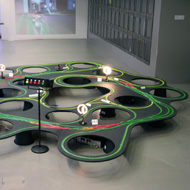| |
|||
 |
|||
| |
|||
| |
|||
|
|
|||
| |
|||
|
|
|||
| |
|||
| |
|||
DAVID MOISES / SEVERIN HOFMANN – TURING TRAIN TERMINAL Installation, 2004 The first scale trains appeared shortly after their models were invented for the benefit of transportation and commerce. Trade and economy likewise spurred the development of computing apparatuses, electronic brains, or as we commonly call them, computers. To disprove a historical (under)estimate, viz. “there will once be computers whose weight will not exceed 1.5 tons” ( Popular Mechanics, March 1949), we used, when mounting a “thinking protozoan” on wheels and tracks, what is the proportional equivalent of tons of steel . Its motor, however, is the universal computer, the Turing Machine, which in theory is capable of calculating everything that is calculable. It only needs to be built on… In the Turing machine, which is based on an idea of Adam Chalcraft and Michael Greene, reading and writing is performed by three types of switches. Setting out from a base position, which is the problem to be calculated, the locomotive itself operates the switches, and connects values and statuses as it passes through them; as it leaves the system, the altered state it leaves behind is the result. Text: David Moises , Severin Hofmann, photo: Severin Hofmann |
